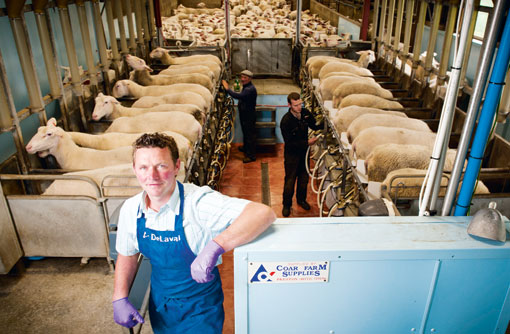How to turn a profit from milking sheep

If you ask the average dairyman about milk yields, figures around the 7,000 litres a cow mark are batted around, but profitable dairying need not revolve around high yields and cows, as emerging markets for other forms of dairy products are set to grow.
For the 2011 Farmers Weekly Sheep Farmer of the Year, Simon Stott, who keeps 500 milking Friesland ewes at Laund Farm, Chipping, Preston, British dairy produce needn’t all be derived from cows.
He says he first got into sheep dairying because he was fed up of seeing foreign sheep cheese on shop shelves, and because a local dairy was beginning to look for English produced sheep milk.
Since then, he has come on leaps and bounds, and is now director of Sheep Milk UK – a co-op consisting of eight producers milking more than 2,500 ewes. Milk from the co-op goes to 12 different dairies across Lancashire and Yorkshire with 95% going into production of Parlick Vale Cheese and the remaining 5% in to liquid milk and yoghurts.
He says at current market prices, sheep milk achieves just over £1/litre and costs approximately 86p/ewe/day to produce. And although the market is currently meeting its demands, there may be opportunities in the future for producers to get involved as the market grows.
Getting started
Producers considering a move into sheep milk production must first assess whether or not there is market demand, and then set up the right infrastructure on their farms, says Mr Stott.
“The investment needed to set up a sheep dairy can be as little or as much as you want,” he explains. “You could spend up to £100,000 on a completely automated system or you could put in a 12 aside yoking system for as little as £10,000.
“However, most people getting involved will want to milk about 300 ewes because that’s the most cost effective and produces a reasonable volume of milk every day; this would require an investment of around £50,000 for a 24:24 parlour.”
Type of sheep
Sheep dairying requires specific breeds of dairy sheep, and Mr Stott has Frieslands which he describes as the “ideal sheep for dairying”.
“The investment needed to set up a sheep dairy can be as little or as much as you want. You could spend up to £100,000 on a completely automated system or you could put in a 12 aside yoking system for as little as £10,000.”
Sheep farmer Simon Stott
“You cannot milk any sheep because of the temperament; Frieslands are ideally designed. They’re lean sheep with a big capacity to hold two to three lambs, as well as long-lasting milk production – four to five lactations,” he adds.
What’s more, he says producers mustn’t forget that dairy sheep are also producing lambs which can be sold as an added profit stream to a sheep dairying business.
“The Friesland sheep isn’t just designed for milking it’s also a very good sheep for rearing lambs. If you crossed a milk sheep, it can produce a lot of milk. The crossbreds are not to be missed as a commercial breed.”
Management
Switching from conventional sheep production to sheep dairying requires management changes in terms of farm set-up, lambing, nutrition and time management.
Mr Stott says: “Farmers would have to get their buildings altered quite a lot and sort out a paddock grazing system. They would also need to learn to get up in the morning for milking – I milk the ewes twice a day at 5.30am and 4pm.
“It’s very labour intensive purely because of the number of lambs produced on the system. At lambing time you have to take all the lambs off the ewes at two days old and put them on to electronic feeders, and they are kept inside for at least ten weeks.”
And when it comes to nutrition, the sheep are kept on a strict TMR mix of silage, whole crop, yeast, molasses, brewers’ grains and an energy mix; they are only put out to grass in good weather conditions.
Maintaining a tight lambing period is also crucial to the success of Mr Stott’s system, where 150 replacements are brought on every year with the view of lambing ewes at 15 months old; most sheep are lambed in January with all replacements lambed in April.
“We run teaser rams for three weeks and then the rams are in with them for 2.5 cycles. And anything that’s barren or suffering from feet or udder problems, goes – we are quite strict.”
Livestock 2012
Get the latest news on the Livestock 2012 event
